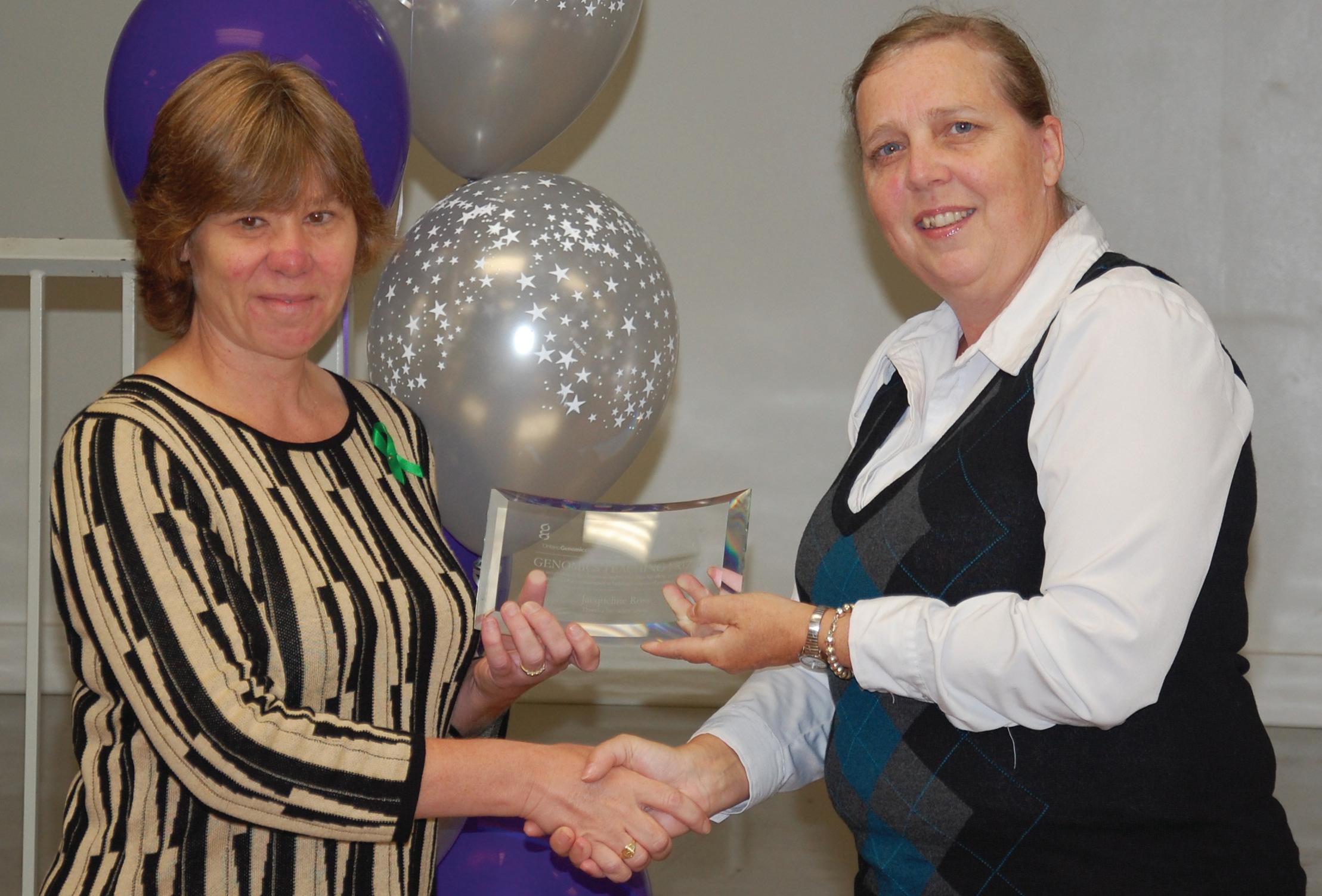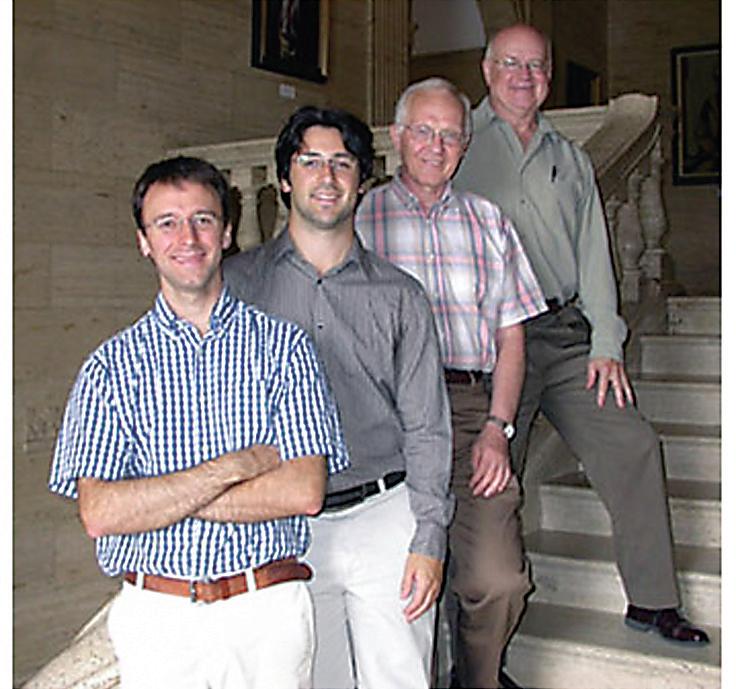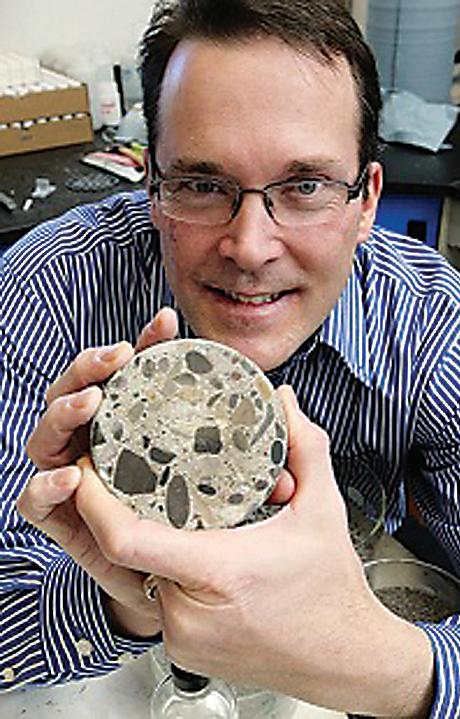
17 minute read
R&D News
www.bioscienceworld.ca
november 2011 volume 15, number 6
Advertisement
2011 readers’ choice awards
Page 8
markham teacher awarded Prize for excellence in teaching genomics
The Ontario Genomics Institute (OGI) has named Thornlea Secondary School teacher Jacqueline Ross as the recipient of its 2011 Genomics Teaching Prize.
Ross has been teaching for 17 years and over the last five years has developed a laboratory-based biotechnology course, which is Jacqueline Ross (Left) of Thornlea Secondary School receiving the Genomics Teaching Prize from Dr. Alison Symington, VP Outreach, Ontario Genomics Institute.

unique to the York Regional District School Board. In addition to the development of the course, Ross secures external guest lecturers and leading scientists in their field to speak to her class about the science of genomics and the societal implications of such research. She also arranges for her students to attend field trips to Dr. Michael Gadsden’s laboratory at Seneca @ York every year where they perform genomic techniques such as restriction enzyme DNA analysis as well as protein characterization.
“The mix of theoretical learning and practical application of scientific knowledge is just one of the reasons Jacqueline was awarded the teaching prize,” said Dr. Mark Poznansky, president and CEO, OGI. “Teachers like Jacqueline are incredibly important in engaging students and providing them with a basis of knowledge about genomics and its importance to every facet of our lives. Teachers play a vital role in helping nurture and R&D News ......................... 1 Pharma Notes.................... 6 Appointments .................... 7 New Products .................. 14 Calendar .......................... 17 Career Spotlight............... 18
encourage tomorrow’s generation of scientists, as well as educating all students about the power of genomics, ensuring tomorrow’s generation is informed about this life-changing area that will undoubtedly play a greater role in health care options, the state of the environment, and the availability and quality of crops for food.”
The OGI Genomics Teaching Prize - which was formally presented to Ross at a ceremony on October 6, which students, parents, fellow teachers, and school administrators attended - includes a $5,000 cash prize and a budget for up to $2,000 in new laboratory equipment and/or instructional materials for the classroom. The award also allows Ross to share her award-winning genomics teaching approach with other life science teachers at a science education conference in the coming year.
“I look forward to using the award to continue providing exciting and interesting classroom exercises, and to expand the educational opportunities available to my students,” commented Ross. “I also look forward to drawing on and contributing to the genomics teaching resources that previous awardees have provided through the OGI website.”
Candidates for the OGI Genomics Teaching Prize are evaluated on their demonstrated excellence in stimulating interest in genomics and teaching students about its impact. Teacher’s use of innovative teaching methods and instructional tools is also evaluated. OGI’s 2011 advisory review panel included a former student of last year’s prize winner, an OGI-funded genomics researcher and experts in life science education including representatives from Ontario’s Ministry of Education, the Science Teachers’ Association of Ontario, Let’s Talk Science, Queen’s University and the University of Western Ontario.
news
Ground-breakinG exPeriment Published in science maGazine
A revolutionary experiment conducted by the University of Ottawa and the National Research Council of Canada’s Joint Attosecond Science Laboratory (JASLab) to solve the mystery of how electrons move in a chemical reaction has been published in the highly esteemed journal Science.
The research produced unprecedented images of how the energy of light is processed in a molecule and showed how electrons move and rearrange as a chemical reaction proceeds.
The team of international scientists from Canada and France worked with nitrogen dioxide molecules (NO2), which is an atmospheric pol-
continued on page 3
CHOICE MATTERSChoose what’s right for you.
Sometimes all you need is reliability. Other times you need a little more bite.

Cell Culture

BD Biosciences
Because No Two Labs are Completely Alike
Science should never be limited by a lack of options. Every lab deserves the freedom to nd tools perfectly suited to speci c needs. VWR is committed to offering broad product choice to a world of accelerating scienti c advancement. We give you direct access to the world’s most respected equipment, supplies, chemicals, furniture, and more. Talk to us about the needs of your lab. We are ready to help you succeed.
Contact your VWR Sales Representative, visit VWR.com, or call 1.800.932.5000 today.
VWR, forms of VWR and the VWR logo and/or design are either registered trademarks ® or trademarks™, or service marks SM of VWR International, LLC in the United States and/or other countries. ©2011 VWR International, LLC. All rights reserved.
PUBLISHER/EDITOR-IN-CHIEF
Terri Pavelic
STaFF wRITER
Shawn Lawrence
CONTRIBUTING wRITER
Deepak Mistry
NaTIONaL aCCOUNT MaNaGER
Patricia Bush
GRaPHIC DESIGNER
Elena Pankova
CONTROLLER
John R. Jones
MaRKETING MaNaGER
Mary Malofy
CIRCULaTION DIRECTOR
James Watson circulation@promotive.net
OFFICE:
24-4 Vata Court Aurora, ON L4G 4B6 Phone: 905-727-3875 Fax: 905-727-4428 E-mail: laboratory_focus@ promotive.net
SUBSCRIPTION INQUIRIES
circulation@promotive.net Fax: 905-727-4428
Laboratory Focus is published 6 times per year by Promotive Communications Inc. Legal Depository: National Library of Canada ISSN 40052410 Subscription rate in Canada $35/year; USA $60/year; other countries $100/year. All rights reserved. No part of this publication may be reproduced without written consent.
Publications Mail Registration Number: 40052410 Return undeliverable Canadian addresses to circulation dept: 24-4 Vata Court Aurora, ON L4G 4B6 E-mail: circulation@promotive.net
If you would like to order hard copy or electronic reprints of articles, contact
Sandra Service 905-727-3875 x228 reprints@promotive.net
ABC Membership Applied For
www.bioscienceworld.ca
news
continued from page 2
lutant. Using an intense femtosecond laser pulse, the scientists recorded the instances after the molecule was struck by the intense light (a femtosecond is to a minute what a minute is to the age of the universe).
The new approach, called high harmonic spectroscopy, allowed the researchers to observe the NO2 molecule until it began to shake and jiggle and eventually separated into a nitrogen oxide (NO) molecule and an oxygen atom.
The experiment mimics the mechanisms involved in vision, where light strikes a molecule and changes its shape, or in photosynthesis, where molecules transform the energy of
light to make biomass from carbon dioxide (CO2). The discovery will contribute to the creation of lower-cost and lower-waste chemical processes and products, impact the light-controlled synthesis of molecules and lead to 4.5x10-LabFocus:2 2011/08/09 2:46 PM Page 1 better solar cells. It also holds tremendous potential for the development of artificial photosynthesis. The joint NRC-University of Ottawa research team included NRC Attosecond Science Program group leader David M. Villeneuve, Herzberg medalist and director of JASLab Paul Corkum, Safeguard Our Aquatic research associate at NRC, Hans-Animal Resources Jakob Worner, and Julien Bertrand, Ph. D student in the Department of Protect aquatic animals against diseasePhysics at the University of Ottawa. NRC-uOttawa Team (Left to Right): Dr. Hans Wörner, Julien Beaudoin-Bertrand, Prof. Paul Corkum and Dr. David Villeneuve (Missing contributor: Daniil Kartashov)

The Natural Sciences and Engineering Research Council of Canada (NSERC) announces the winners of its 2011 Innovation Challenge Awards.
When a highrise building is subjected to an extreme earthquake, significant damage can occur throughout the concrete walls and beams. Michael Montgomery developed an innovative technology for reducing wind and earthquake vibrations in these buildings, called the Wind-Earthquake Coupling Damper. For this work, Dr. Montgomery, who completed a graduate degree at the University of Toronto, received the first prize, worth $10,000.
For broadening the use of lasers that help to diagnose certain medical conditions, Martin Bernier, the first runner-up, received $5,000. In close collaboration with industrial partners, Bernier, who did his graduate studies at Université Laval, developed the FibreLase technology, enhancing the use of lasers in biomedical applications to improve patient care.
In large industrial organizations, shutting down massive machines for a maintenance check can be costly. Viet Hung Vu, who completed a graduate degree at École de technologie supérieure, created MODALAR-STAR, a software program that helps identify and monitor vibration properties in large industrial machinery and structures during operation. Vu received $5,000 as second runner-up for his research contributing to greater machine efficiency.
Nine other researchers each received an honourable mention prize of $1,200.
The Innovation Challenge Awards were launched in 2004 by NSERC and the Canadian Science and Technology Growth Fund. The program is currently funded by the Business Development Bank of Canada (BDC), NSERC and
If you find or suspect a reportable disease in finfish, molluscs or crustaceans, you must tell the Canadian Food Inspection Agency nserc announces 2011 innovation (CFIA). Reportable diseases could seriously harm Canada’s aquatic challenGe awards animals, international trade and the economy. The CFIA works to private sector contributions. Other fiprevent these diseases from being introduced into, and spreading nancial contributors include AB Sciex, within, Canada. Research In Motion, Syncrude, the Dairy Farmers of Canada and 3M. For more information and a listing of “These awards encourage graduate reportable aquatic animal diseases, students to explore the real-world call 1-800-442-2342 or visit implications of their research. I am www.inspection.gc.ca/aquatic very impressed with the high calibre of the nominations we received from universities across Canada,” said Dr. Suzanne Fortier, President of NSERC. “These young researchers understand that the ability to translate new knowledge into innovative products and services is a crucial factor in pushing Canada to new levels of innovation.”4.5x10-LabFocus:2 2011/08/09 2:46 PM Page 1
Contribuons à la protection de nos ressources animales aquatiques
Protégeons les animaux aquatiques des maladies
Si vous décelez ou soupçonnez la présence d’une maladie déclarable chez des poissons, des mollusques ou des crustacés, vous devez en informer l’Agence canadienne d’inspection des aliments (ACIA). Une maladie déclarable peut avoir des effets néfastes sur les animaux aquatiques du Canada, le commerce international et l’économie. L’ACIA s’efforce de prévenir l’introduction et la propagation de ces maladies au pays.
Pour de plus amples renseignements et pour obtenir une liste des maladies des animaux aquatiques déclarables, appelez le : 1-800-442-2342 ou consultez le : www.inspection.gc.ca/aquatique
Reply card #4494
Safeguard Our Aquatic Animal Resources
Protect aquatic animals against disease
If you find or suspect a reportable disease in finfish, molluscs or crustaceans, you must tell the Canadian Food Inspection Agency (CFIA). Reportable diseases could seriously harm Canada’s aquatic animals, international trade and the economy. The CFIA works to prevent these diseases from being introduced into, and spreading within, Canada.
For more information and a listing of reportable aquatic animal diseases, call 1-800-442-2342 or visit
www.inspection.gc.ca/aquatic
Reply card #4494
news
new bridGe to be built with stronGer concrete develoPed bY the nrc

Dr. Daniel Cusson The National Research Council of Canada (NRC) has developed a more durable concrete that will increase the average lifespan of bridge decks by more than 20 years compared to typical highstrength concrete, and by more than 40 years compared to normal-strength concrete.
This high-performance concrete has been specially formulated to minimize shrinkage, which is typical of high-strength concrete, while maintaining its excellent mechanical properties. It also greatly reduces cracking, which diminishes the penetration of aggressive agents into the concrete, such as chlorides from the de-icing salts used on roads. As a result, it takes considerably more time for the chlorides to reach the steel reinforcement, initiate corrosion, and induce further damage to the structure.
“The key difference is in the sand—lightweight porous shale fi ne aggregate, which replaces about a quarter of the normal sand used to make concrete,” said Dr. Daniel Cusson, a senior researcher at the National Research Council. “This porous sand can hold up to 20 per cent of its own weight of water, which serves to uniformly cure the concrete from the inside, thus preventing selfdesiccation.”
With a unit cost only 5 per cent higher than that of standard high-strength concrete, Dr. Cusson expects concrete bridge decks made with this new concrete will last longer, save taxpayers money from annual bridge maintenance, recurring repairs and associated traffic disruption and replacement.
Currently, this new selfcuring high performance concrete is being put to the test at the NRC outdoor slab testing facility, where its mechanical performance and corrosion resistance is being monitored with embedded instrumentation and periodic non-destructive testing.
This new concrete formulation is being considered for the deck construction of the Canal Bridge, which is part of the North Channel Bridge replacement project in Cornwall, ON.The $75 million infrastructure project from Federal Bridge Corporation is currently underway.
structural genomics consortium announces new funding and Partners
The Structural Genomics Consortium (SGC) has announced $48.9 million in new funding and that two new commercial partners have joined the Consortium.
Eli Lilly Canada and Pfi zer, Inc. are the newest members of the consortium, joining the Canadian Institutes for Health Research, GlaxoSmithKline, the Novartis Research Foundation, the Ontario Ministry of Research and Innovation and the Wellcome Trust. Together, these organizations have committed nearly $50 million to the consortium to sustain it for another four years of operation. The four pharmaceutical company partners will provide more than $9 million worth of in-kind contributions, primarily medicinal chemistry resources, for collaborative discovery of chemical tool compounds that target disease-linked proteins. This wealth of structural information may help to improve human health by providing research reagents and protocols, and robust frameworks for structure-guided discovery of new medicines for cancer and diabetes, among other diseases and disorders.
The Structural Genomics Consortium (SGC) is based at the University of Oxford and the University of Toronto, Canada. It was formed in 2004 and carries out research on human proteins relevant to disease, supported by funding from the public and private sector. It makes all of its fi ndings available to the global research community without restriction.
The SGC has plans to University of Toronto the epigenetics binders project.



broaden its work, following successful pilot projects in ‘epigenetics’ with two new programmes on antibodies and chemical tools. These will focus on epigenetic phenomena - heritable changes in gene function that occur without changes in the underlying DNA sequence. Alterations in these processes are linked to many common diseases, and there is broad agreement that a better understanding of epigenetics may eventually yield new approaches to diagnosing and treating a number of important diseases. It is hoped that the research will generate antibodies against proteins involved in epigenetic control, and identify chemical compounds that block the action of specifi c human proteins. These tools - protein structures, antibodies and chemical inhibitors - are important early steps that facilitate the drug discovery process, targeting proteins involved in disease processes.
Thus far, the SGC has contributed more than 1,300 highquality three-dimensional protein structures to the public domain.
HIGH PURITY PRODUCTS FOR LABORATORY CHEMISTRY
Caledon Labs, proudly Canadian. Celebrating 40 years!
visit caledonlabs.com for our latest promotion!


2012 inductees named to canadian medical hall of fame
The Canadian Medical Hall of Fame announces that Dr. John James Macleod (1876-1935), Terry Fox (1958-1981), Dr. Armand Frappier (1904-1991), Dr. Peter Macklem (1931-2011), Dr. John Dirks, Dr. F Clarke Fraser and Dr. Lap-Chee Tsui have been named as its 2012 inductees.
“These individuals have truly made a difference in the lives of Canadians, and indeed, people around the world. They have blazed trails, inspired others to follow, and extended the boundaries of medical knowledge and health care,” said Dr. Cecil Rorabeck, Board chair of the Hall of Fame. “We are in their debt, and we honour them for their great service to humankind.”
Dr. John James Rickard (JJR) Macleod is recognized for collaborating in one of the most important breakthroughs in medicine. Known internationally at the time for his research in carbohydrate metabolism and physiology, Dr. Macleod was recruited to the University of Toronto where he directed the research that led to the discovery and clinical use of insulin as an effective therapy for diabetes. Following the breakthrough in 1922, Dr. Macleod shared the 1923 Nobel Prize in Physiology or Medicine with Dr. Fredrick Banting.
Terry Fox’s run to raise money for cancer research in 1980 is an enduring symbol of the commitment and determination of one individual to fi nd a cure - shared now by millions of people who participate in Terry Fox events all over the world. Today, the Foundation in his name has raised hundreds of millions of dollars. Terry’s father and brother, Rolly and Darrell, will accept the honour at the induction ceremony in Toronto in March.
Dr. Armand Frappier was a driving force in the deadly battle against tuberculosis. In the 1930s, he became an advocate for full-scale, anti-tuberculosis vaccinations in North America, and founded the fi rst institution dedicated to medical research in Québec now known as the INRS-Institut ArmandFrappier. During the polio epidemic of the 1950s, Dr. Frappier introduced the Salk vaccine. He is also recognized for his work in the development of freeze-drying human serum, in collaboration with the Department of National Defence and the Canadian Red Cross during WWII.
One of Canada’s greatest pulmonary physicians, clinician-scientists and original thinkers, Dr. Peter T Macklem forever changed the face of respiratory medicine by pioneering the study of small airway physiology and identifying the early pulmonary damage done by smoking. Born in the Thousand Islands region of Ontario, he is recognized worldwide as a giant of respiratory medicine.
Dr. John Dirks of Toronto has had a long and distinguished career working in the fi eld of kidney disease. But he is perhaps best known for transforming the Gairdner Foundation International Awards, often referred to as ‘Canada’s Nobel Prizes’, into one of the most prestigious award programs for medical research in the world.
Raised in Nova Scotia, Dr. F Clarke Fraser is an iconic fi gure in Canadian medicine. His work spanned the fi elds of science and medicine, and was one of the creators of the discipline of medical genetics in North America. He founded the first Canadian medical genetics department in a paediatric hospital, aptly named the F Clarke Fraser Clinical Genetics Centre at McGill University, in 1995. He also laid the foundations in the fi eld of genetic counselling, which has enhanced the lives of patients worldwide.
Dr. Lap-Chee Tsui made what is described as the most significant breakthrough in human genetics in 50 years, namely the discovery of the cystic fi brosis gene. Born in Shanghai, China, and coming to the Hospital for Sick Children in Toronto in the early 80s, Dr. Tsui has made extraordinary contributions to science through his discoveries and is a leader in developing the fi eld of genomics in Canada and internationally.
The 2012 Induction Ceremony, will be held for the fi rst time in Toronto on March 21, 2012 and will see the seven inductees join the ranks of 88 laureates who have been similarly honoured since 1994.

The Perfect Combination.
Detergents To Maximize Your Miele Lab Washer.
Our range of professional cleaning detergents delivers residue-free results, extended life of your laboratory glassware and proper care for your Miele Lab Washer. With decades of experience, the end results are cleaner than clean. Experience it for yourself today.
mieleprofessional.ca
Reply card #4493
Manufacturer direct service available: 1-888-325-3957 Toronto • Montreal • Calgary • Edmonton • Vancouver

news
new technoloGY helPs sPinal disc reGeneration
A new biomedical technology that can treat back pain immediately has been developed by a multidisciplinary team of Queen’s researchers.
“This technology could revolutionize back pain treatment,” said James Hayami, the lead researcher and a doctoral candidate in the Department of Chemical Engineering who specializes in biomedical engineering.
Currently the best thing that can be done in terms of surgical repairs is to alleviate pain by removing some of the bone that’s pinching the nerve, removing the herniated disc itself, or doing spinal fusions. There have been no regenerative treatment options that maintain the architecture of the spine or that have immediate results.
This technology is an injectable synthetic polymer mixture that takes form inside the body and increases the space between the vertebrae of the spine, alleviating any pain caused by pinched nerves. The biodegradable nature of this supporting structure means that it disappears over time as new tissue is regenerated.
While other similar supporting technologies are created outside the body and inserted via invasive surgery, this new injectable form is designed to be minimally invasive. In a single-step process, stem cells or cells taken from damaged tissue are added to the polymer mixture. The mixture is then injected into the body and the structure takes form. Tissue regeneration then takes place in the space the structure creates.
The cushioning centre of spinal discs and the cartilage that allows our joints to function smoothly are both non-regenerative. This new minimally invasive, regenerative technology means that people could be treated quickly and get back to their normal lives.
These findings will appear in an upcoming issue of Macromolecular Bioscience.



